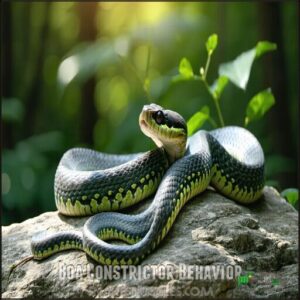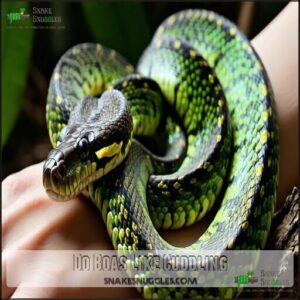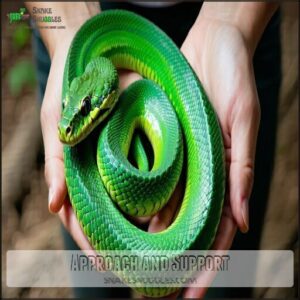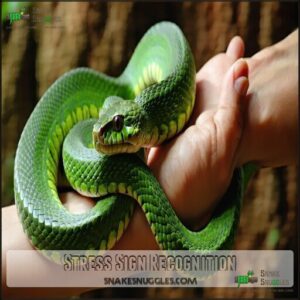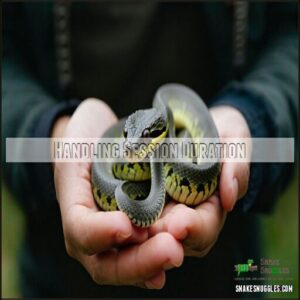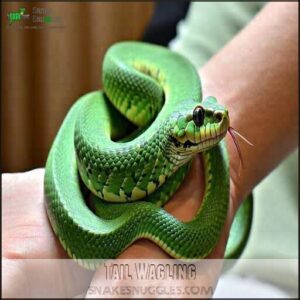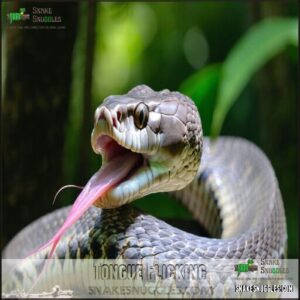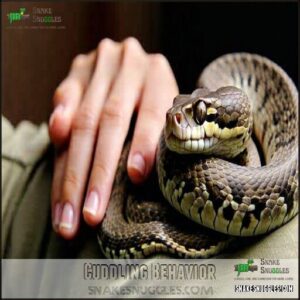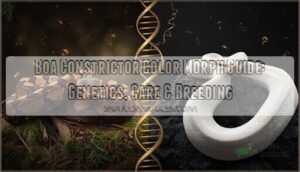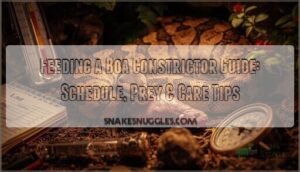This site is supported by our readers. We may earn a commission, at no cost to you, if you purchase through links.

These snakes are solitary by nature, so their “affection” isn’t emotional—it’s practical. If your boa wraps around you, it’s likely for warmth, security, or to explore its surroundings, not because it enjoys snuggling.
They can grow comfortable with being handled if you’re gentle and consistent, but it’s more about tolerance than bonding. Your boa might seem cozy, but remember, it’s driven by instinct, not love.
Understanding their behavior helps build trust, making interactions safer and more enjoyable—for both of you. Curious about signs of trust?
Table Of Contents
- Key Takeaways
- Boa Constrictor Behavior
- Do Boas Like Cuddling
- Handling Techniques Matter
- Creating Stress Free Environment
- Ethical Boa Ownership
- Bond Formation Basics
- Signs of Boa Affection
- Building Boa Trust
- Frequently Asked Questions (FAQs)
- Do boa constrictors like to be held?
- Do boa constrictors bond with their owners?
- Can boa constrictors recognize specific scents or voices?
- How do boa constrictors perceive human contact?
- Do boa constrictors show preferences for certain textures?
- What factors influence a boas daily activity patterns?
- Can music or vibrations affect a boas behavior?
- Conclusion
Key Takeaways
- Boa constrictors don’t cuddle for affection—they wrap around you for warmth, security, and exploration.
- These snakes are solitary by nature, so handling builds tolerance, not emotional bonding like with pets.
- Calm movements and proper support during interactions help them feel safe and more comfortable over time.
- Recognizing your scent and routine, they associate you with safety, leading to trust and familiarity.
Boa Constrictor Behavior
You’ll notice that boa constrictors are naturally solitary creatures, preferring to spend their time alone rather than seeking companionship.
Boa constrictors thrive solo, embracing independence over companionship, a true reflection of their solitary predator instincts.
Their behavior depends on factors like temperament, past experiences, and how they perceive interactions, especially handling.
Solitary Nature
Boa constrictors are independent creatures with a solitary lifestyle shaped by their natural instincts as solitary predators.
They thrive with limited socialization and minimal companionship, focusing on survival rather than snake interaction.
In the wild, their reptile behavior revolves around hunting and resting alone.
Understanding this snake behavior helps you respect their boundaries in snake pet interaction, ensuring healthy reptile care.
Handling Perception
Snakes aren’t naturally social, so handling often feels like an initial threat.
With time, boas can form positive associations if interactions are gentle. Early handling leaves a lasting impact on temperament, while gradual habituation makes them more comfortable.
Understanding boa constrictor behavior, coupled with snake handling tips, helps avoid stress. Remember, their snake cuddling habits aren’t affectionate, but tolerance grows.
Temperament Variation
Handling a boa brings surprises—no two have the same temperament.
Early experiences, genetic influence, and quality of care shape their individual personalities. Some are mellow, while others display cage defensiveness or prefer little interaction.
Snake handling impacts comfort levels over time. With patience and consistency, even a shy boa constrictor temperament can shift toward tolerance of handling.
Recognizing that they may exhibit stress through hissing is essential for responsible handling, and understanding boa constrictor temperament and stress through hissing can significantly improve the experience, as it involves patience and consistency and awareness of their unique individual personalities.
Do Boas Like Cuddling
Cuddling with a boa constrictor might sound adorable, but it’s not what they’re built for.
Boa constrictors don’t cuddle for affection—they seek warmth, security, and familiarity, not emotional bonding like humans do.
Their solitary nature means affection, as humans perceive it, isn’t part of boa constrictor behavior. Reptile affection is often misunderstood; boas don’t seek hugs but can grow comfortable with handling when it’s done right.
What you might see as snake pet cuddles is really a mix of curiosity, body support, and warmth-seeking. Boa comfort signs, like calm muscle tone and slow tongue flicking, suggest trust, not love.
Owner interpretation often labels their behavior as cuddly, though it’s more about familiarity from consistent, gentle handling. Reptile bonding exists in a practical sense—your boa recognizes you and tolerates interaction based on its temperament and how you’ve treated it, which can lead to a form of reptile bonding.
Handling Techniques Matter
In the case of boa constrictors, how you handle them makes a big difference in their comfort and behavior.
Using proper techniques helps reduce stress and keeps both you and your boa safe.
Approach and Support
When handling a boa, a gentle approach is key.
Use proper support with both hands—one near the head and one under the mid-body.
Avoid dangling them; it makes them feel insecure.
A secure hold helps them feel safe, building positive associations with handling.
Snake handling works best with calm movements and proper hand placement for comfort.
For added grip and safety, some handlers choose to use specialized handling equipment.
Stress Sign Recognition
When moving on to recognize snake stress signs, watch for things like rapid breathing, muscle tension, or escape attempts.
Hissing sounds or striking behavior also indicate discomfort.
Understanding snake body language makes snake handling techniques easier and safer.
These stress signs mean it’s time to pause, giving your boa a chance to relax before resuming interaction, which is crucial for a safe and successful handling experience.
Handling Session Duration
Too much handling can stress a boa, so keep sessions short at first.
Gradually increase durations to build comfort. Always respect your snake’s limits and look for signs of stress.
Remember these essentials:
- Avoid handling for 48 hours post-feeding.
- Stick to short, gentle sessions until trust grows.
- Start with once or twice weekly to prevent snake stress.
Creating Stress Free Environment
Creating a stress-free environment for your boa constrictor is essential for its comfort and well-being.
By providing the right enclosure, temperature, and humidity, you’ll help your boa feel safe and secure in its space.
Enclosure Requirements
A proper snake enclosure keeps your boa healthy and calm.
Choose an enclosure size that allows your boa to stretch fully. Add hiding spots for comfort, a substrate choice that retains moisture, enrichment items like branches, and clean water access.
Boa constrictors feel secure in a well-thought-out enclosure setup, encouraging natural behavior and reducing stress.
It’s important to maintain proper temperature gradients for thermoregulation, which is crucial for the boa’s overall health and well-being.
Temperature Gradient
Getting the enclosure right isn’t just about space. A proper temperature gradient is key for thermoregulation, letting your boa move between a warm basking spot (around 90°F) and a cooler side (75°F).
Think of it like their personal thermostat. Proper gradients are essential, and you can purchase necessary equipment online.
Use reliable heat sources to maintain balance, ensuring your snake stays comfy and healthy in their environment.
Humidity Control
Humidity control is essential for healthy snake enclosure conditions.
Aim for snake humidity levels of 50-70% to avoid shedding problems or respiratory infections. Use a hydrometer for accurate monitoring and adjust misting frequency as needed.
Substrate choice, like cypress mulch, impacts humidity. Don’t forget: snake temperature requirements influence moisture levels too!
A balanced setup guarantees comfort and prevents health issues. Many rely on specialized humidity products for consistent control.
Ethical Boa Ownership
Owning a boa constrictor means putting its well-being first, ensuring it’s handled safely and responsibly.
You’ll need to research their needs and respect their boundaries to provide ethical care.
Prioritizing Boa Needs
When caring for boa constrictors, prioritizing their needs is key to keeping them healthy and comfortable.
Focus on enclosure security and creating a stress-free space by following these steps:
- Provide appropriate thermal regulation and humidity levels.
- Add multiple hiding places for their comfort.
- Guarantee a quiet environment to reduce stress.
- Regularly monitor the enclosure for cleanliness and wellbeing.
Handling Precautions
When handling your boa, safety comes first. Always approach calmly, support its body evenly, and monitor stress signs like rapid breathing or muscle tension.
Never handle after feeding or during shedding—it’s uncomfortable for them. Wash hands before and after for hygiene. Supervise kids closely, and stay consistent to avoid bites.
Keep handling relaxed to build trust. Remember to use a snake hook carefully for initial lifting.
| Precaution | Why It’s Important | What to Do |
|---|---|---|
| Safe Handling | Prevents stress or injury | Support entire body evenly |
| Bite Prevention | Guarantees safety for all | Avoid overly sudden moves |
| Shedding Sensitivity | Reduces unnecessary stress | Skip handling during shed |
| Hygiene Practices | Prevents illness transfer | Wash hands before/after |
| Child Supervision | Promotes safe interactions | Always supervise handling |
The table outlines key precautions for handling boas, including bite prevention, shedding sensitivity, and hygiene practices. By following these guidelines, you can ensure a safe and enjoyable experience for both you and your boa. Always prioritize safety and handle your boa with care.
Responsibility and Research
Respecting a boa’s boundaries isn’t just good manners—it’s about responsible ownership.
Ethical acquisition matters; always source from reputable breeders following legal considerations.
Snake pet ownership is a long-term commitment, so research species-specific needs like temperature and habitat.
A solid reptile care guide guarantees proper boa constrictor care and minimizes conservation impact.
Remember, being informed avoids frustrations and supports ethical considerations.
Bond Formation Basics
You might think boas form bonds like cats or dogs, but their relationships work a little differently.
With time and consistent handling, they can recognize you and even associate your presence with safety.
Recognition and Association
A boa’s solitary nature doesn’t stop them from recognizing familiar faces.
Through sensory perception and positive association, they identify you as safe. They remember your scent, warmth, and routine, forming a type of bond.
While it’s not affection as we experience it, their conditioned behavior might surprise you.
- Familiar human recognition is possible
- Association grows with trust
- Memories guide interaction
- Solitary species bonds exist
- Routine builds familiarity
Owner Preference
You might notice your boa showing subtle signs of affection, like calmly resting in your presence or exploring your scent.
Owner bonding takes patience, as temperament influences their reactions. While snake cuddling facts suggest they’re not warm and fuzzy pets, their unique personalities make interaction benefits rewarding.
Each boa constrictor personality varies—building companionship relies on understanding individual variation in human-reptile relationships.
To facilitate this, it’s essential to support snake bodies fully during handling, which is crucial for building companionship and creating a strong human-reptile relationship.
Building Trust
Building trust with a boa constrictor pet requires patience and consistent interaction.
Start with gentle handling in a safe environment, keeping movements slow and steady. Early handling helps form positive associations, making boa constrictors more relaxed over time.
Trustbuilding is like planting seeds; nurture it with care. A calm, predictable routine can strengthen the snake pet bond and deepen mutual comfort.
Signs of Boa Affection
You might wonder if your boa constrictor shows affection, even though they’re not social animals like dogs or cats.
Signs like tail wagging, tongue flicking, or calmly resting on you could mean they’re comfortable and accustomed to your presence.
Tail Wagling
Tail wagging in boas isn’t like a dog’s wag—it’s snake communication at play.
This curious behavior can signal comfort, excitement, or curiosity in certain situations.
Wagging and trust often go hand-in-hand, showing a relaxed connection with their environment or handler.
Individual variation means not all boas display it, but observing snake pet behavior helps decipher their unique body language and wagging frequency.
Tongue Flicking
Tongue flicking is like a snake’s way of reading the room. Boas use sensory input to gather chemical signals, aiding in environmental exploration and prey detection.
Long, frequent flicks show curiosity or comfort, while short, infrequent ones signal nervousness. Here’s what to watch for:
- Relaxed flicking: curiosity.
- Rapid flicks: exploration.
- Rare flicks: stress.
- Around humans: comfort.
- Steady rhythm: calm communication cues.
Cuddling Behavior
Boa constrictors don’t cuddle like humans, but they may seek security in physical contact.
Wrapping around you or resting their head nearby shows comfort, not snake pet affection as we imagine.
Owner experiences vary, with boas sometimes showing bond perception through handling.
They enjoy warmth, so “cuddling” likely satisfies survival instincts more than affection.
| Behavior | Why It Happens | What It Means |
|---|---|---|
| Wrapping around | Seeking security | Comfort, not affection |
| Resting on owner | Enjoying warmth | Trust, basic survival |
| Inactivity | Feeling safe, secure | Relaxed snake pet behavior |
Building Boa Trust
Earning a boa constrictor’s trust takes time, consistency, and a calm approach. Since these snakes are naturally solitary, you’ve got to work on creating positive associations.
Gentle handling is key—support their body evenly and avoid sudden movements, which can startle them. Gradual habituation helps them feel safe, especially if interactions happen in a secure enclosure where they already feel comfortable.
Regular, consistent interaction encourages your boa to recognize you, relying on familiar smells and routines to build a sense of familiarity. Over time, they may even tolerate or enjoy handling as part of their experience.
Remember, each snake’s temperament is unique, so patience is essential. With a little effort, your boa constrictor will learn that you’re not a threat, just a caring presence!
Frequently Asked Questions (FAQs)
Do boa constrictors like to be held?
Picture holding a warm, living rope with muscles; that’s a boa constrictor in your hands.
They don’t "like" being held, but with gentle handling, they’ll tolerate it and might even seem to enjoy the interaction.
Do boa constrictors bond with their owners?
They don’t bond like a dog would, but boas can recognize you over time.
With consistent handling, they may tolerate or enjoy interaction, associating you with safety and comfort rather than seeing you as a threat.
Can boa constrictors recognize specific scents or voices?
Imagine walking into a room—your scent says hello before you do.
Boa constrictors can recognize familiar smells, but voices don’t register the same way.
Instead, they rely on scent and vibrations to navigate interactions.
How do boa constrictors perceive human contact?
Boa constrictors don’t perceive human contact as affection, but with consistent, gentle handling, they might tolerate or even enjoy it.
It’s less about "liking" and more about comfort, trust, and familiarity you build together.
Do boa constrictors show preferences for certain textures?
A boa’s preference for textures is like their taste in cuisine—varied and unique.
They often favor smooth, warm surfaces, like your arm, over rough or cold ones, as these feel safer and more familiar.
What factors influence a boas daily activity patterns?
Your boa’s daily activity hinges on its habitat, temperature, and light cycles.
They’re most active at night, exploring quietly, hunting, or basking.
Stress, hunger, and enclosure design can also shift their behavior substantially.
Can music or vibrations affect a boas behavior?
It’s like feeling bass through your chest—boa constrictors sense vibrations more than sounds.
Loud music or heavy vibrations can stress them out, but soft, consistent rhythms might help them feel calm and secure.
Conclusion
Imagine holding a heating pad—that’s how a boa might see you.
While boa constrictors don’t like to cuddle in the emotional sense, they can grow comfortable with handling when treated gently and respectfully.
Their wrapping behavior is more about seeking warmth and security than affection.
If you recognize their signs of trust, like calm stillness or gentle tongue flicking, you’ll deepen your connection.
Treat your boa’s instincts with care, and interactions will feel rewarding for both of you.

